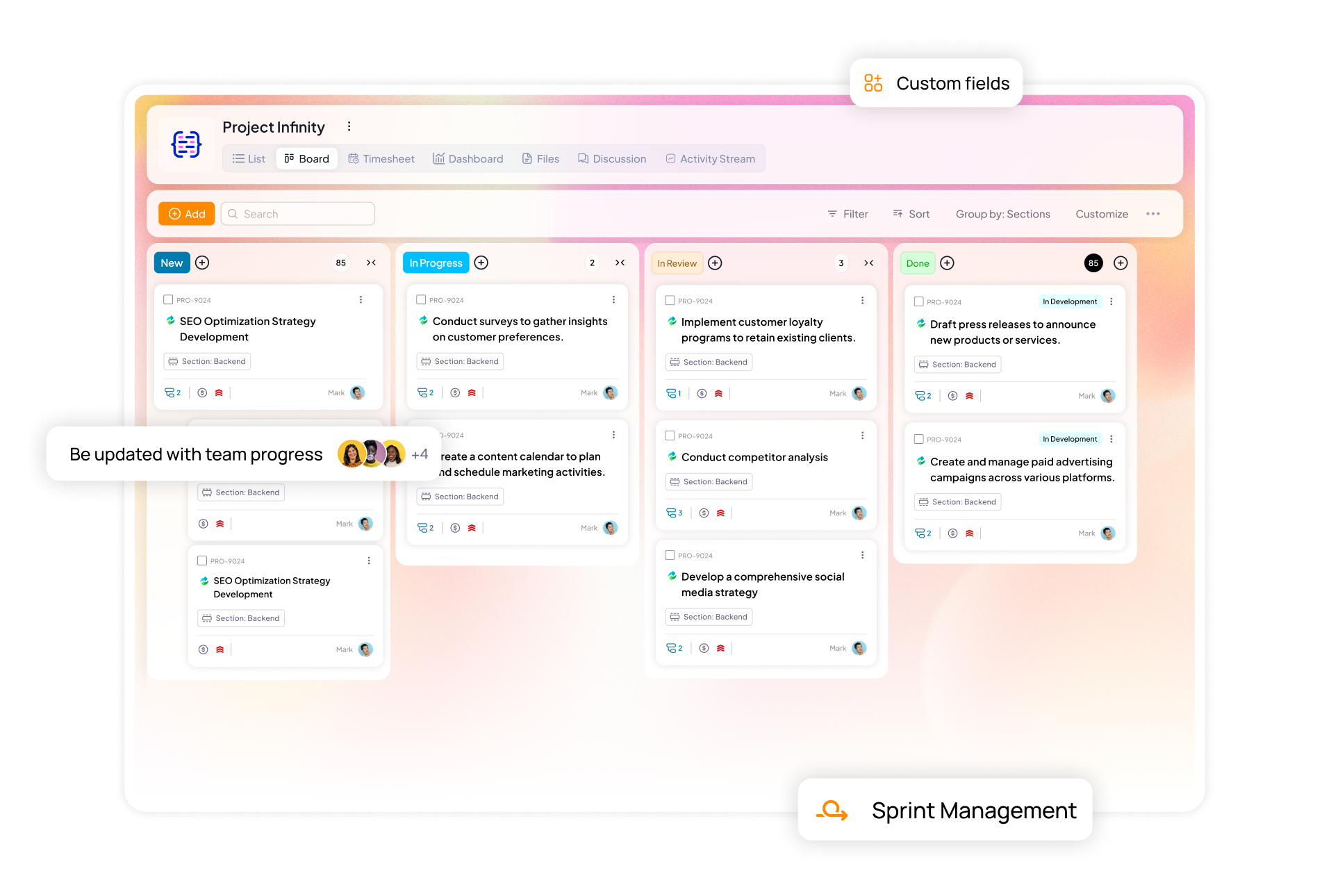You’ve felt the first spark of a campaign resonating deeper than expected. It could be a sudden surge of momentum that confirmed you’re onto something real. When you start delivering campaigns that consistently surpass your expectations, you’d naturally want to do the same for all your clients over the long term. The logical next step is building a building a high-performing marketing team that can take that spark and shape it into a self-sustaining fire.
You’re searching for more than marketers. People who feel the weight of every word, and who never lose sight of the fact that behind every campaign is a person you’re trying to reach, and maybe even change.
If no one has ever been able to give you a clear picture of how to build a high performing marketing team, this article will tell you how.
The exact steps you need to take to build a dream marketing team
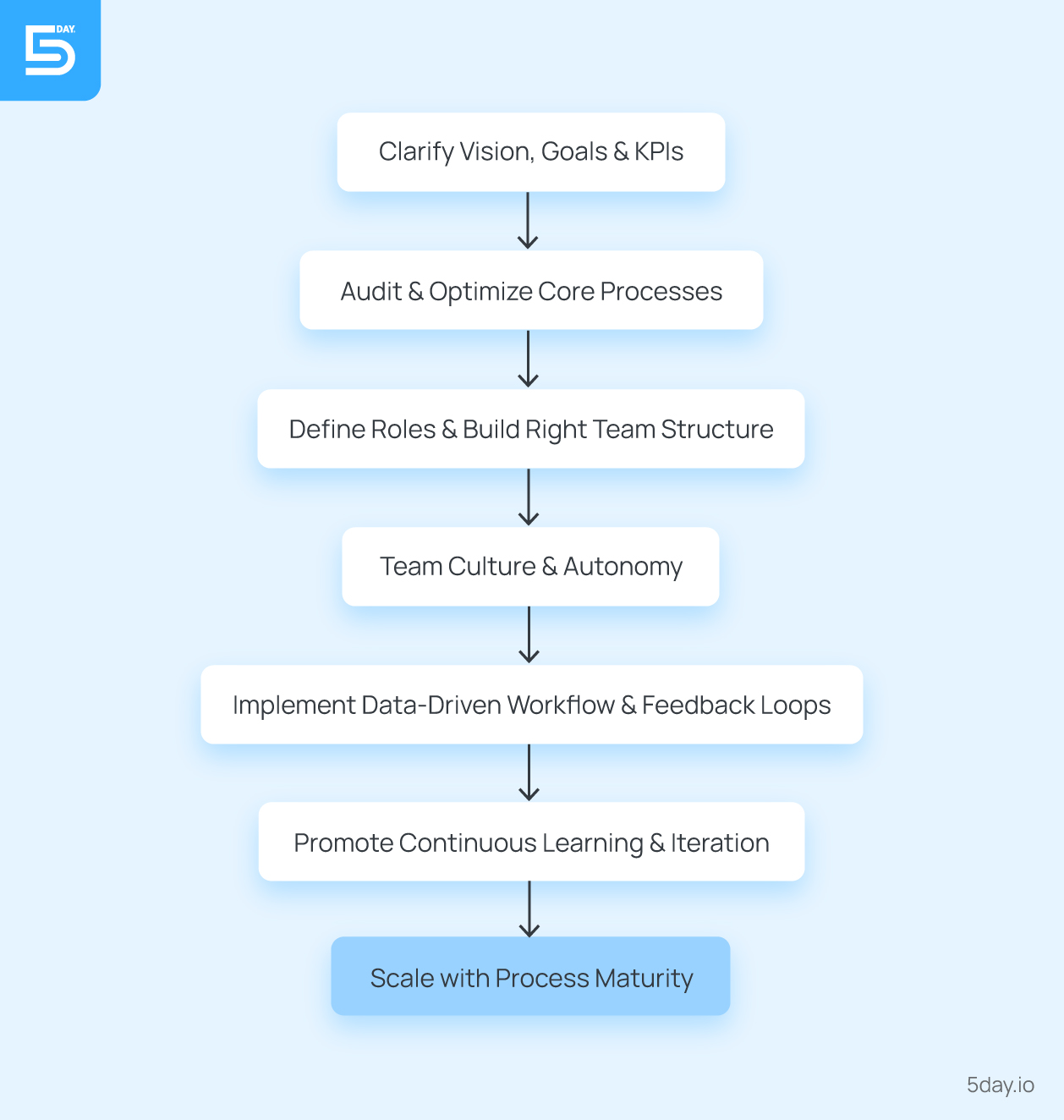
You don’t really need an all rock-star team. That’d just be unrealistic. What you need are go-getters and the following steps to shape their vision and fuel them as they go.
Step 1: Clarify vision, goals and KPIs
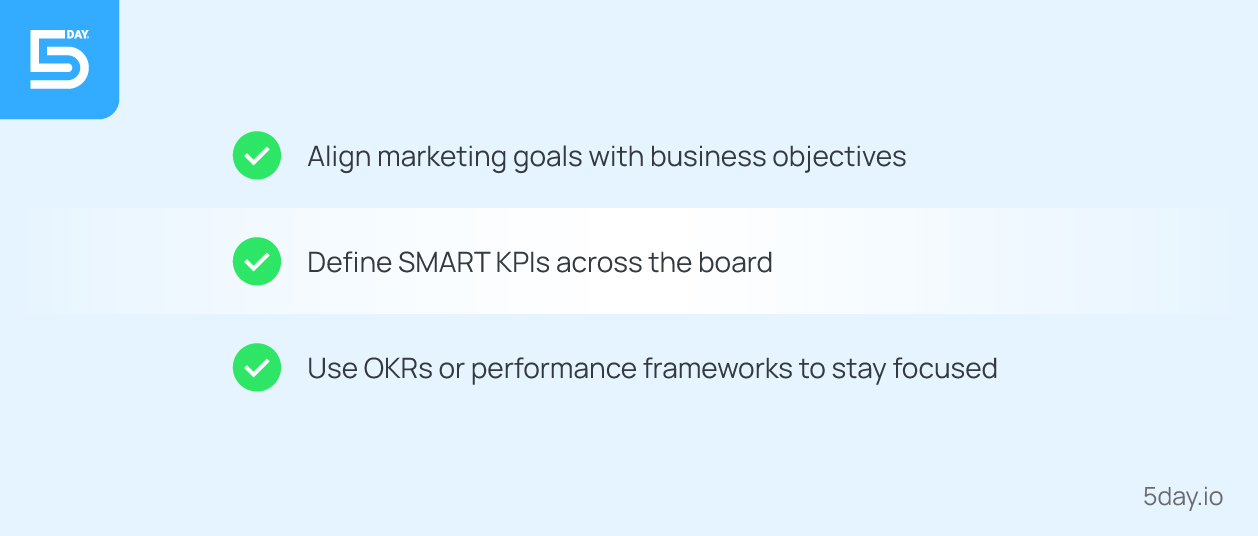
Get everyone on the same page about what you’re working toward, and how you’ll measure success.
Many marketing teams jump straight into campaign plans and execution without ever stepping back to ask: “Wait, what are we actually trying to achieve here?” Before you start working on anything, you need to zoom out and get clear on the bigger picture.
Align marketing goals with business objectives
If your marketing team is chasing goals that don’t support the company’s bigger business targets, it’s like rowing really hard in the wrong direction.
Let’s say the company’s aiming to grow revenue by 30% this year. That means marketing should focus on building better lead-gen funnels, improving conversion rates, building awareness of your offering across different stages, and running campaigns that bring in high-quality traffic.
When your team knows why they’re doing what they’re doing, everyone starts making smarter decisions.
Define SMART KPIs across the board
Now that your goals are locked in, it’s time to get specific. Pick up SMART KPIs that are Specific, Measurable, Achievable, Relevant, and Time-bound.
Set them across different parts of marketing, so your team knows exactly what winning looks like.
| For brand awareness | Track things like direct traffic, branded search volume, and share of voice (basically, how often you show up compared to competitors) |
| For acquisition | Look at your Customer Acquisition Cost (CAC), cost per lead (CPL), or how many Marketing Qualified Leads (MQLs) are actually turning into real sales conversations |
| For retention | It’s not just about getting new users, how are you keeping them? Watch churn rates, reactivation campaigns, email engagement, and Customer Lifetime Value (CLV) |
| For revenue | Tie your campaigns directly to money. Track marketing-sourced revenue, average deal value, and how much return you’re getting for every rupee (or dollar) spent |
Use OKRs or performance frameworks to stay focused
Even with great KPIs, it’s easy for a marketing team to get distracted. Shiny new ideas pop up and people forget what matters most.
This is where OKRs (Objectives and Key Results) or other goal-setting frameworks come in handy. They help everyone focus on a few high-impact goals at a time, and make sure progress is actually being tracked.
Let’s say your quarterly objective is:
“Generate more high-quality leads through content.”
Your key results could look like:
- Publish 10 SEO-optimized blog posts
- Improve MQL to SQL conversion from 18% to 30%
- Cut CAC by 20%
When people clearly see how their work connects to the company’s success, they step up. They become more creative, and more accountable.
Why this step really matters
This first step is what separates high-performing teams from teams that just stay busy.
Step 2: Audit and optimize core processes
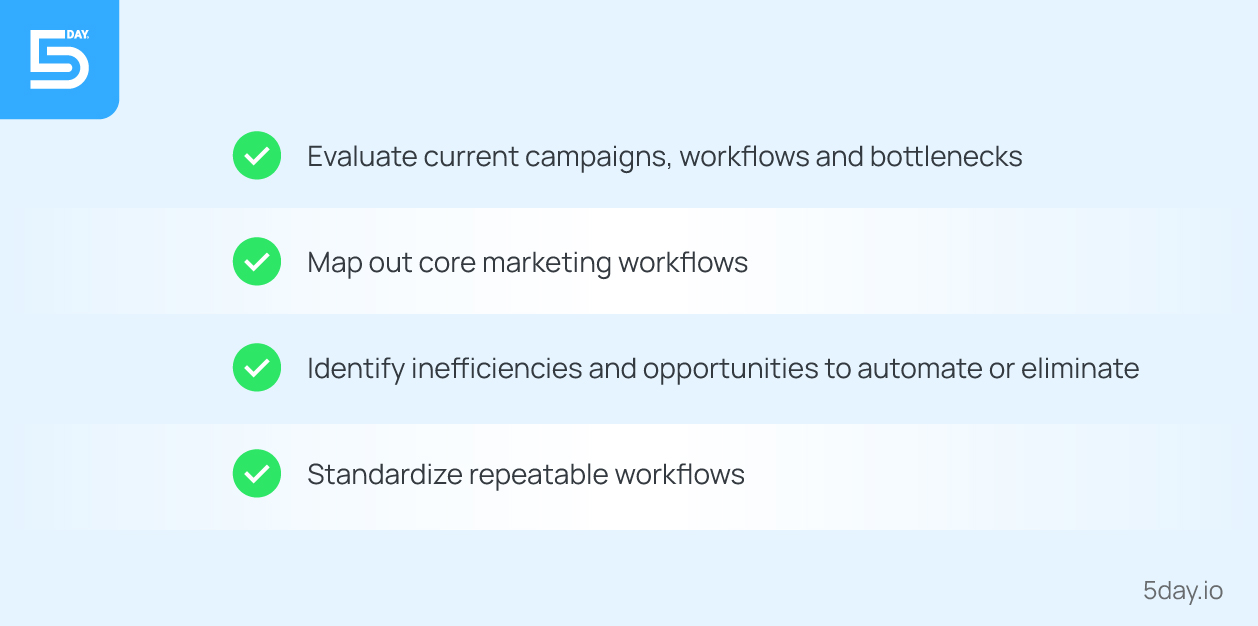
It’s time to look under the hood. Is your marketing processes built to deliver consistent, scalable results, or are they just happening?
This step is all about doing a deep dive into how your team is currently working, what’s smooth, and what’s secretly eating up everyone’s time.
Evaluate current campaigns, workflows and bottlenecks
Start by asking how does work actually get done in this team?
Take a look at current and recent campaigns, from ideation all the way to launch.
- Where are the delays happening?
- Are handoffs between design, copy, and paid ads smooth?
- Are approvals slowing everything down?
- Is content created collaboratively or is anyone working in silos?
- Are people communicating regularly with each other or are there breakdowns?
- Does your team spend too much time on low-impact tasks just to keep things moving?
A simple whiteboard session listing each major marketing workflow can reveal surprising inefficiencies. And if you’re seeing the same types of issues across different projects? That’s a pattern worth solving.
Map out core marketing workflows
Now it’s time to document how your team does the work. Map out:
| Content creation workflows | Who requests what? Where’s the brief? How’s it approved? |
| Campaign planning timelines | How far in advance do you prep? What’s your launch checklist? |
| Lead generation and handoff processes | How are leads captured, scored, and sent to sales? |
| Email sequences or drip journeys | Who’s writing, who’s setting them up, and how’s performance tracked? |
Read Also: How Does Project Management Software Simplify Content Creation
Identify inefficiencies and opportunities to automate or eliminate
Every marketing team has time sinks. Once you’ve mapped the workflows, look for steps that can be automated (using tools like 5day.io), delegated, or removed entirely. Ask questions like:
- Can this be templatized?
- Is there a tool that can handle this better?
- Are we doing this because it works, or just because we’ve always done it?
Eliminating even a few small inefficiencies can dramatically improve marketing team efficiency and free up hours every week.
Standardize repeatable workflows
Now that you’ve cleaned things up, it’s time to lock in the improvements. Document your new processes in simple, clear playbooks. These could be SOPs (standard operating procedures), templates, checklists, or even a quick Loom video walking through a task.
Make it easy for your team to do repeatable tasks well, every single time. Standardized processes create mental freedom by reducing decision fatigue.
Why this step matters so much
You could have the best creative ideas in the world, but if campaigns keep getting delayed or results can’t be tracked, it doesn’t matter. That’s why this step is super crucial.
Step 3: Define roles and build the right team structure
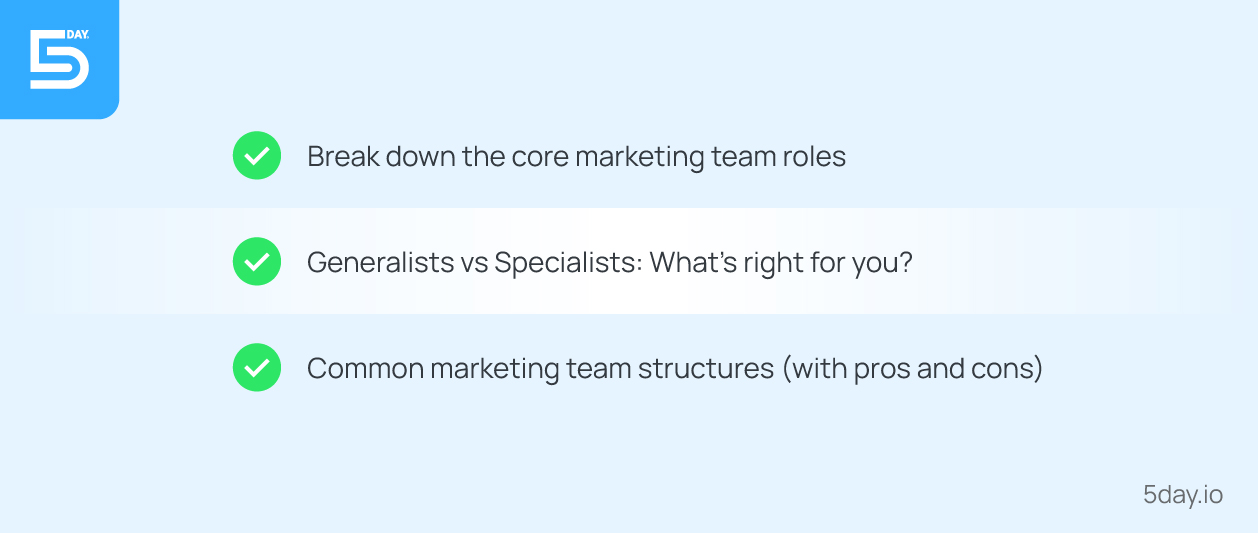
This step is all about figuring out who you need on the team, what they’re each responsible for, and how everyone fits together.
Break down the core marketing team roles
Let’s start with the basics, what roles should a modern marketing team include? While every company’s needs will vary depending on size, industry, and stage, these are the foundational roles you’ll find on most high-performing teams:
| Content Marketer / Strategist | Owns blogs, whitepapers, video scripts, case studies, and overall content planning. They’re your brand’s storyteller. |
| SEO Specialist | Ensures your content is discoverable. Handles keyword research, on-page optimization, and technical audits |
| Paid Ads Manager | Runs your Google, Meta, LinkedIn, and other ad campaigns. Focuses on CAC, ROAS, and lead gen at scale |
| Marketing Analyst / Ops | Builds dashboards, tracks performance, and ensures data-driven decisions. Often owns tools like GA4, HubSpot, or Looker |
| Social Media Manager | Builds engagement and brand affinity. From daily posting to influencer collabs and reactive content |
| Designer / Creative Lead | Creates all visuals, from social posts to landing pages and display ads. Ensures everything looks and feels on-brand |
| Email Marketer / CRM Manager | Nurtures leads, boosts retention, and personalizes journeys through well-crafted email flows |
| Product Marketer | Bridges product and marketing. Crafts messaging, leads go-to-market efforts, and arms sales with positioning and assets |
If you’re small, some of these may be combined into hybrid marketing team roles and responsibilities. But knowing what each should look like helps you hire or delegate smarter as you grow.
Generalists vs Specialists: What’s right for you?
One of the most common early questions is: Should I hire one person who can do a bit of everything, or several people who each own a narrow slice?
Generalists shine in small teams or early-stage startups. Great if you’re figuring out what works and needs broad coverage. Specialists come in when you’ve found traction and want to go deep. The sweet spot for many teams is a hybrid approach, a few strong generalists supported by a few deep specialists in critical areas.
Read Also: Your No-Nonsense Marketing Agency Project Management Guide
Common marketing team structures (with pros and cons)
How you organize your team matters as much as who’s on it. Here are a few tried-and-tested marketing team structures that high-performing teams use:
1. Hub-and-spoke model
A central brand/strategy team supports smaller channel-specific “spokes” (like paid, content, social). This is best for mid-to-large teams with a strong brand focus and multiple workstreams. It’s easy to keep messaging consistent and gives good visibility for leadership. That said, there’s always a risk of central team becoming a bottleneck if not managed well.
2. Pod-based teams
These are small cross-functional pods own specific goals or customer segments. For example, one pod might own “SaaS Enterprise” and another “Mid-Market DTC.” It’s great for companies with multiple products, segments, or markets. These teams are agile, autonomous, and customer focused. Feels like a startup within a team. However, you also risk of duplication across pods or inconsistent branding.
3. Agile squads
Agile marketing mimics agile engineering. Teams run sprints, have standups, retros, and iterate fast. This is perfect if you need a team to focus on high experimentation (like growth marketing). It encourages speed, collaboration, and constant learning. On the other hand, it also requires strong project management.
You can also mix and match, some orgs use hub-and-spoke for brand + pods for growth.
Why this step matters
Taking the time to define the right roles and build the structure that fits your stage helps avoid burnout, and confusion.
Step 4: Foster a culture of ownership, autonomy and collaboration

The best teams feel empowered to experiment, speak up, and solve problems without waiting for permission.
Build a culture of accountability, creativity and experimentation
A successful marketing team isn’t afraid to try new things and isn’t punished when something doesn’t work out.
Instead of focusing only on outputs, focus on outcomes.
- What impact are those efforts driving?
- Are they helping the business grow?
- Are they solving a customer pain point?
Encourage your team to bring fresh ideas and run small experiments. Create regular spaces to share what’s working and what’s not, team huddles, “show & tell” sessions, even informal Slack threads. Celebrate smart risks.
Encourage cross-functional collaboration
Some of the biggest performance jumps come when marketing works with other departments, not in silos.
Sales can share real-time insights about what messaging lands (and what doesn’t). Product can give previews of what’s launching next, so your team isn’t playing catch-up. Customer Success can surface the exact pain points and feedback your audience cares about.
Make collaboration a default. Invite other teams to planning meetings. Create shared dashboards. Align goals (e.g., “qualified leads” or “feature adoption”) so everyone is rowing in the same direction.
The best marketing teams are trusted internally because they’re great listeners.
Empower people with autonomy and clear decision rights
Give people the autonomy to own their lane and learn from their own results. If your content lead knows the overall goal is to drive 500 leads this month, let them decide the best mix of articles, formats, or channels to get there. Guide them, support them, but don’t hover.
Make sure every team member knows:
- What they’re responsible for
- What decisions they can make on their own
- Who to pull in for feedback or approvals
Confident marketers take bigger swings and create better work.
Why this step is a game-changer
A team that feels ownership will push harder. A team that’s trusted will move faster. This is how you build a truly agile marketing team.
Read Also: Task Management Guide for Marketing Teams
Step 5: Implement a data-driven workflow and feedback loops
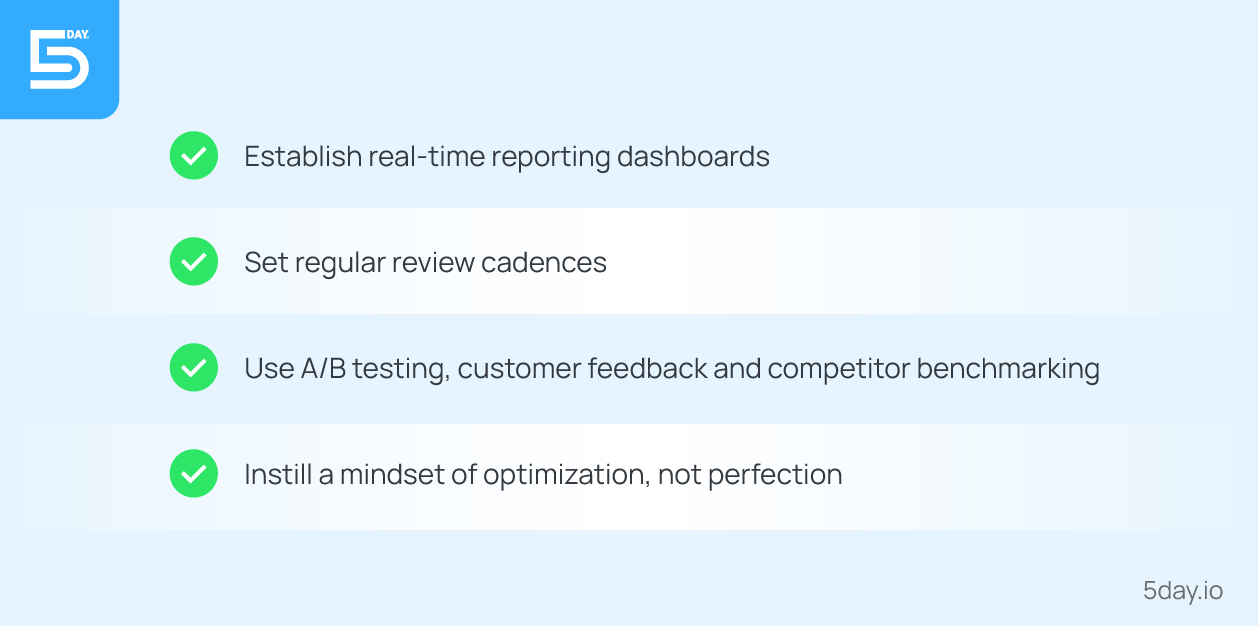
A crucial step in building a truly high-performing marketing team is creating systems for continuous learning and improvement. This means moving from gut instinct to data-backed decisions and making feedback a habit.
Here’s how to make that happen.
Establish real-time reporting dashboards
Let’s start with visibility.
Set up dashboards that track your key marketing KPIs across content, acquisition, email, paid ads, SEO, and more. Tools like Google Looker Studio and HubSpot can be great depending on your stage.
A good dashboard should answer questions like:
- Are we hitting our lead targets this week?
- What campaigns are driving the most marketing ROI?
- Where is engagement dropping off?
- Which channels are underperforming?
No more waiting till the end of the month to realize something went off-track two weeks ago.
Set regular review cadences
Now that you have data flowing in, it’s time to build a rhythm around it. High-performing teams talk about it consistently.
Set up a simple cadence like this:
| Weekly standups | Quick 15-30 min syncs to review key metrics, blockers, and wins |
| Monthly performance reviews | Deeper dive into what’s working, what’s not, and what to double down on |
| Quarterly strategy reviews | Zoom out. Revisit your OKRs. Realign on what needs to shift for the next sprint or quarter |
If your team already does reviews, ask: Are they useful or just calendar fillers? The best review meetings lead to action, not just reporting.
Use A/B testing, customer feedback and competitor benchmarking
Optimization needs to be a part of your day-to-day process now.
Encourage your team to test everything, even pricing if you’re in product marketing. Use tools like Google Optimize, Optimizely, Meta Ads A/B tools, or even native email platforms.
At the same time, listen to your users. Use surveys, social DMs, NPS responses, and customer calls to gather feedback. What are customers asking for? What confuses them? What delights them?
Then, look around. Benchmark your performance and campaigns against your top 3-5 competitors. What are they doing differently? Are there formats, or strategies they’re owning that you’re missing?
Instill a mindset of optimization, not perfection
Perfection sounds noble, but in marketing, it often leads to stalled growth. Instead, coach your team to focus on launching, and learning.
Done is better than perfect if you have a feedback loop in place. This mindset not only increases speed, but it also increases resilience. Your team becomes less afraid of failure, and more excited by possibility.
Why this step is the secret weapon
If you want to improve marketing team efficiency and scale sustainably, this is the engine behind it. Everyone gets better, week after week.
Read Also: The Future of Work Management Shaping Marketing Agency Workflows
Step 6: Promote continuous learning and iteration
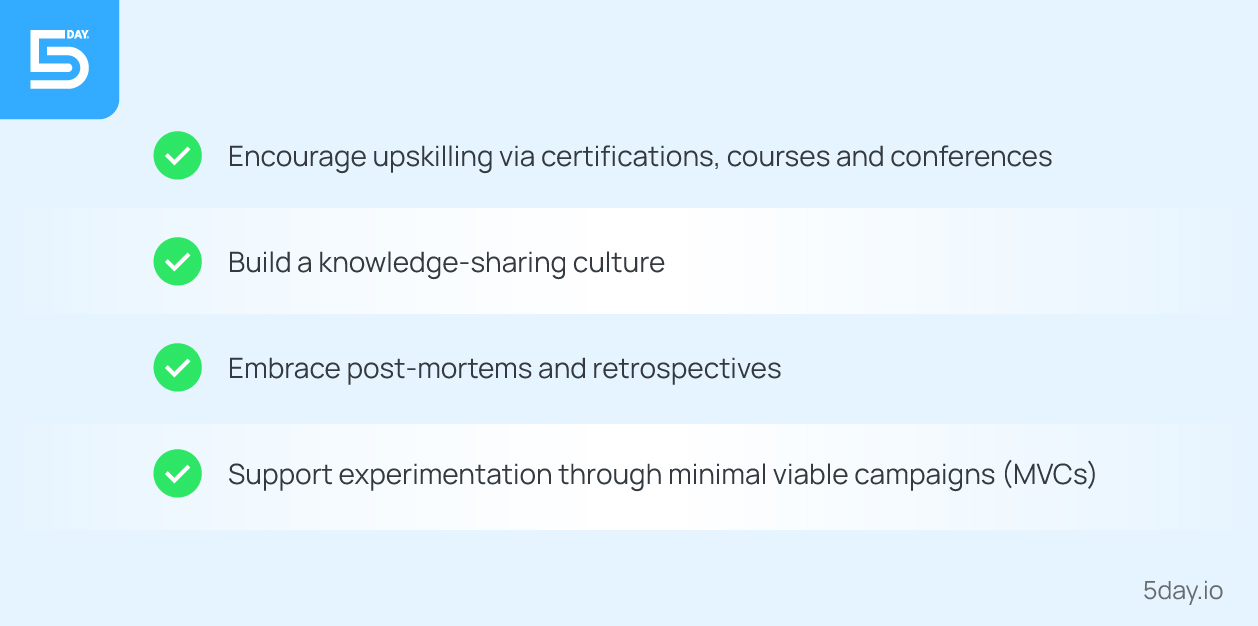
If you want your marketing team to keep thriving, you need to bake learning into the culture. To keep up with changing trends, your team needs an environment that actively promotes growth and iteration.
This is an ongoing) piece of the puzzle in building a high-performing marketing team: turning your team into a learning machine.
Encourage upskilling via certifications, courses and conferences
Give your team time and budget to pursue certifications, online courses, or marketing bootcamps.
Even better? Support attendance at conferences, and local meetups. These events spark inspiration and keep your team plugged into where the industry is headed.
And if the budget is tight? Bring learning in-house. Host monthly “skill-share” sessions where one team member teaches something they’ve learned.
Build a knowledge-sharing culture
Create lightweight ways for your team to share what they’re learning:
- Set up a dedicated Slack channel for insights, screenshots, and tips.
- Host lunch & learn where a team member presents a topic they’ve explored (tools, tactics, trends).
- Use an internal wiki to document how-tos, playbooks, A/B test results, or lessons learned from campaigns.
Embrace post-mortems and retrospectives
Not every campaign is going to work. And that’s okay, as long as you learn from it.
After each major campaign or project, hold a retrospective. Make it safe to talk about:
- What worked well?
- What didn’t go as planned?
- What surprised us?
- What would we do differently next time?
Make sure these sessions are blame-free and focused on learning.
Support experimentation through minimal viable campaigns (MVCs)
Sometimes, the pressure to launch big, polished campaigns holds teams back from trying new things. That’s where the Minimal Viable Campaign (MVC) approach comes in.
Instead of spending weeks perfecting a campaign, build a lean version to test the core idea:
- Launch a simple landing page to validate a new offer
- Test a new ad creative with $100 in spend
- Send a short, scrappy email campaign to gauge interest
If it flops, you haven’t wasted weeks. If it clicks, now you have proof to invest more.
Why this step keeps you future-proof
It’s the fuel that keeps everything else going.
Step 7: Scale with process maturity
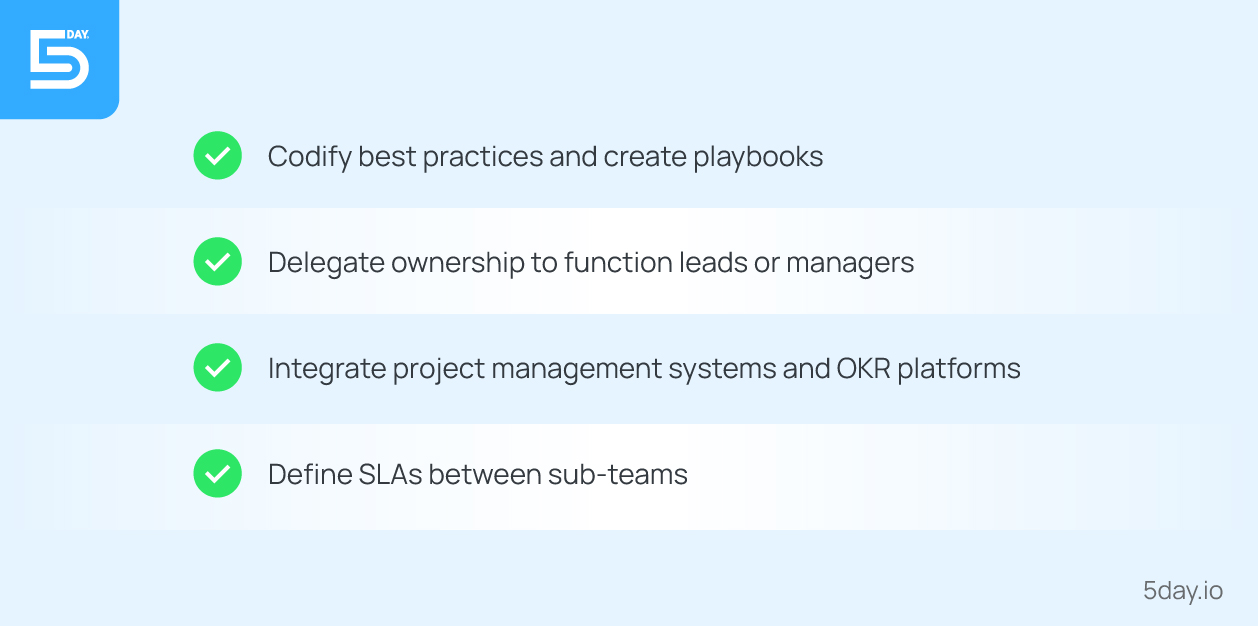
Now it’s time to scale with intention.
The real challenge now is doing great work at scale without burning out your team or reinventing the wheel every time. That’s where process maturity comes in.
Codify best practices and create playbooks
The best marketing teams codify their success.
Start creating simple, repeatable playbooks for things like:
- Writing and launching a blog post
- Planning a campaign from scratch
- Setting up and optimizing ad experiments
- Email nurture sequences or onboarding flows
- Working with influencers or affiliates
These don’t need to be rigid or overly complex. Even a doc, or Loom walkthrough can do the trick. The point is to make it easy for anyone to plug in and get moving.
And as things evolve, update the playbooks.
Delegate ownership to function leads or managers
As you grow, start handing off clear ownership of channels and functions to capable team leads.
This might mean:
- A content lead owning the editorial calendar and tone of voice
- A paid media manager responsible for monthly ROAS
- A design lead owning prioritization and creative QA
- A marketing ops lead managing tech stacks and reporting systems
As you delegate, also clarify what decisions they can make independently, and what should come back to leadership.
Integrate project management systems and OKR platforms
As headcount and projects grow, you need to bring in tools that help your team stay aligned and accountable.
- Use project management software (like 5day.io) to plan and track deadlines, and dependencies.
- Use OKR tools to track team-level objectives, and progress over time.
- Create shared calendars and campaign timelines so everyone sees what’s launching and when.
Everyone should know where things stand, and who’s responsible.
Define SLAs between sub-teams
As your team expands into specialized functions, you’ll hit a new kind of challenge, or interdependencies.
Solve this with SLAs (Service Level Agreements), clear expectations between internal teams. For example:
- Design requests for content should be delivered within 3 business days
- Analytics dashboards for new campaigns go live within 48 hours of request
- Landing pages need a minimum 5-day heads-up before a launch
SLAs create help people plan better.
Why this step protects everything you’ve built
Scaling is about making sure the quality of work stays high even as complexity increases. And that only happens when you start thinking like an organization, not just a team.
How does 5day.io bolster your high-performing marketing team?
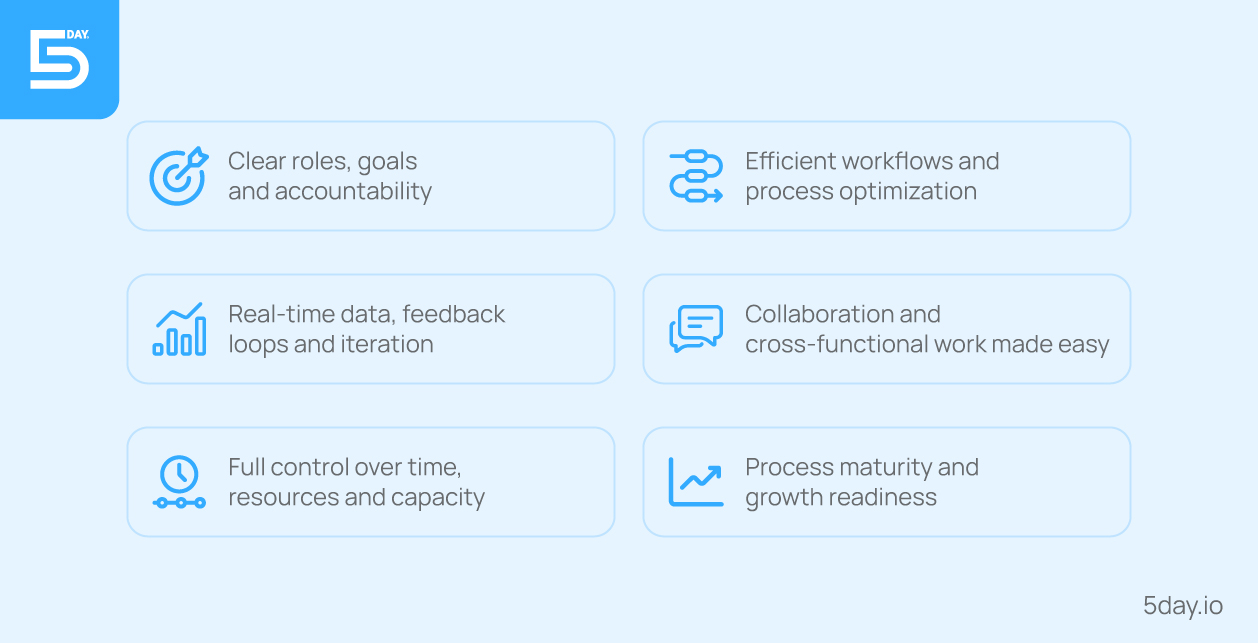
Your marketing team is only as strong as the systems that support it. 5day.io brings the structure, and collaboration needed to help high-performing teams move faster.
Read Also: How to Collaborate Better for Marketing Agencies
Clear roles, goals and accountability
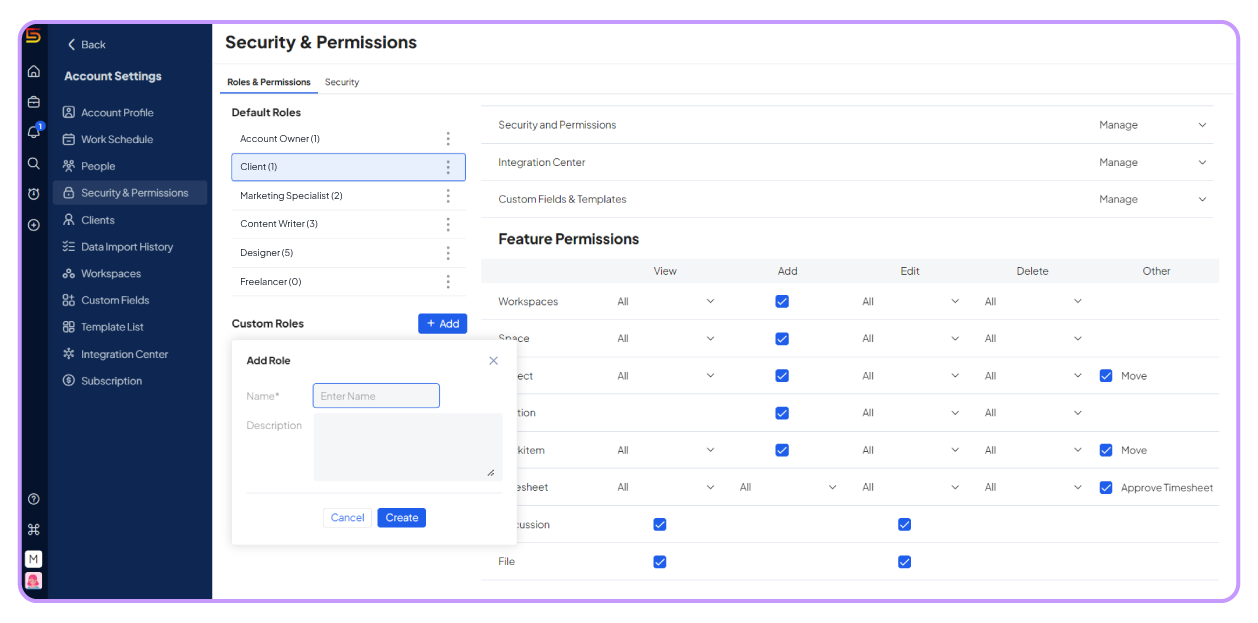
5day.io allows you to assign marketing team roles and responsibilities with precision, thanks to its customizable projects, and granular task ownership. Each person knows what they’re responsible for and how it ties back to broader marketing goals.
You don’t need to chase updates, visibility is built in.
Efficient workflows and process optimization
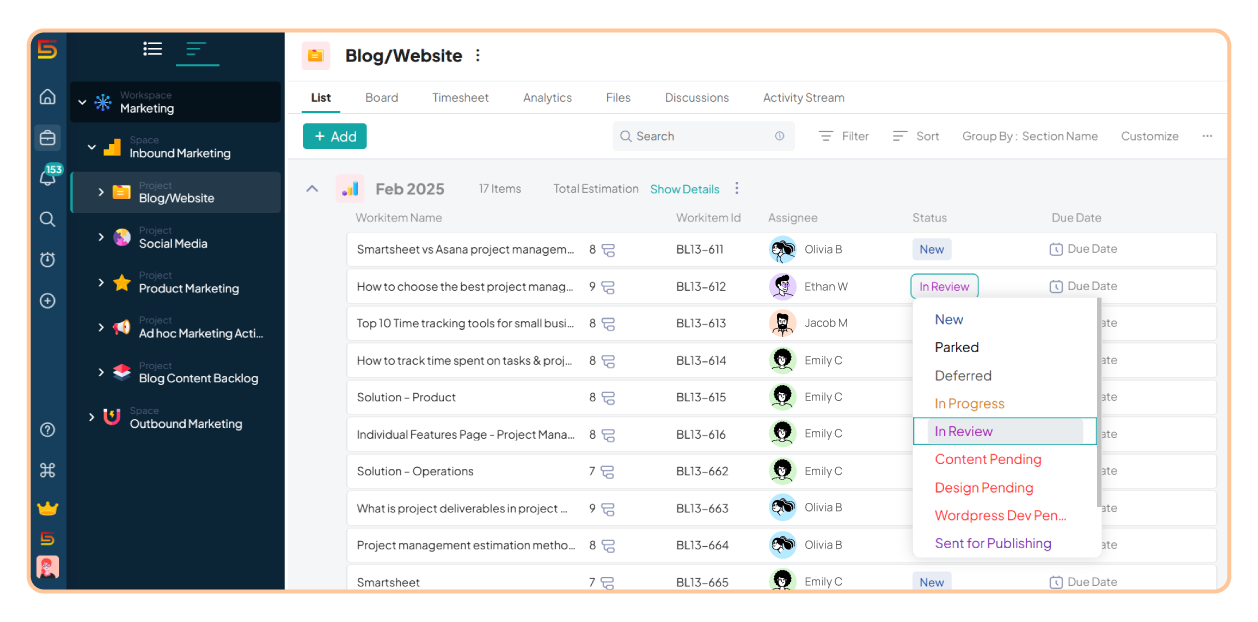
High-performing marketing teams thrive on consistency, and 5day.io delivers it through deeply customizable workflows. From the moment a new campaign is conceptualized, you can define automated actions on every step.
The platform supports linked tasks, meaning no one starts design before copy is ready, and no one is left waiting without context. You can also automate recurring tasks, bulk update multiple items at once, and build reusable templates for newsletters, or product launches.
Real-time data, feedback loops and iteration
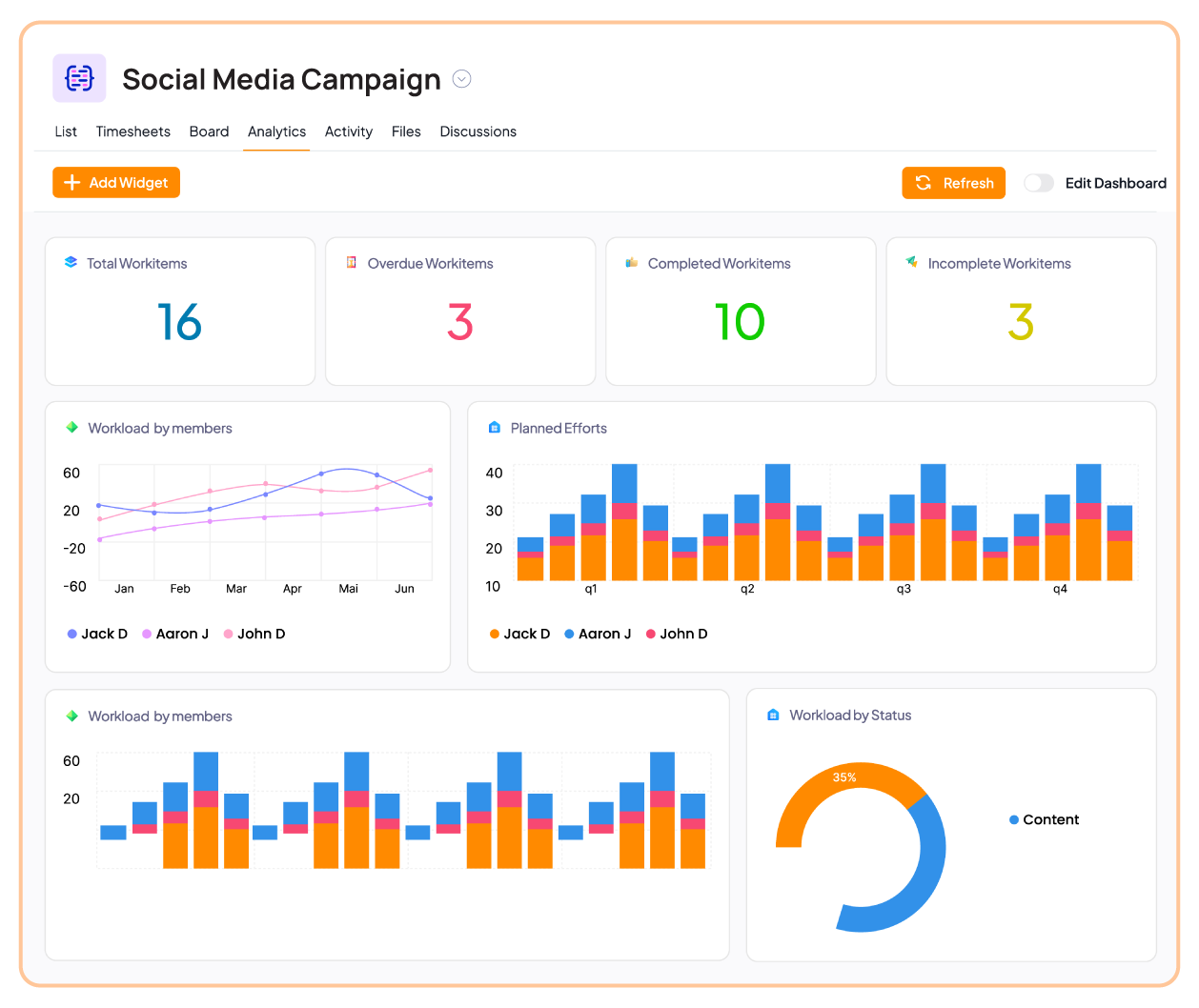
5day.io equips your team with real-time analytics dashboards that track what matters, from task progress, campaign performance, or time spent on specific workstreams.
You can visualize results through various chart formats like bar, pie, line, and doughnut, helping the team spot trends and act quickly. Post-campaign retrospectives and activity streams give you a clear picture of what worked and what didn’t.
Collaboration and cross-functional work made easy

5day.io makes collaboration seamless with features like real-time commenting, threaded discussions, tagging, and file uploads that support all major media formats. Everything stays within the platform. Native integrations ensure no message is missed, and nothing falls through the cracks.
Full control over time, resources and capacity
![]()
Time is a marketing team’s most limited resource, and 5day.io treats it as such. The built-in timesheet and time-tracking system allows team members to log hours easily (even in bulk), categorize tasks as billable or non-billable. Your team can also set reminders, so no effort goes undocumented.
Managers get a clear view of team capacity and utilization, making it easier to balance workloads. This is how you improve marketing team efficiency at the operational level.
Process maturity and growth readiness
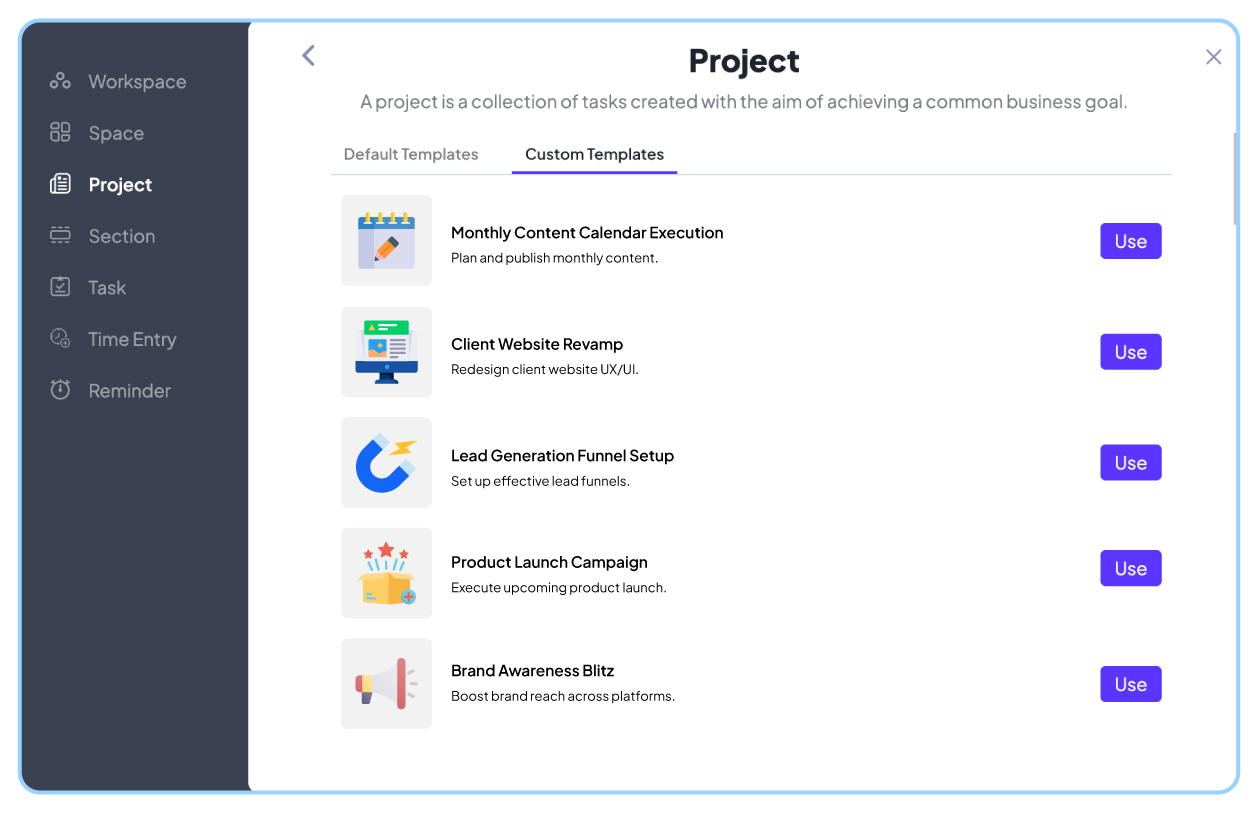
As you scale your marketing efforts, you need a tool that grows with you, without becoming clunky. 5day.io makes it easy to standardize excellence by offering pre-built and custom templates for campaigns, and client reporting. You can also define service-level agreements (SLAs) in form of a template and onboard sub-teams to review it. For example, specifying design turnaround times for content or expected feedback loops for ad creatives.
The platform supports advanced project views like list and board views, along with bulk import/export, and duplication of projects.
Get a complete walkthrough of the product by signing up for a 3-month free trial today.
Not only will you get access to our full suite, but you will also be handheld by the best of our customer support executives, to make your trial easier than ever.





